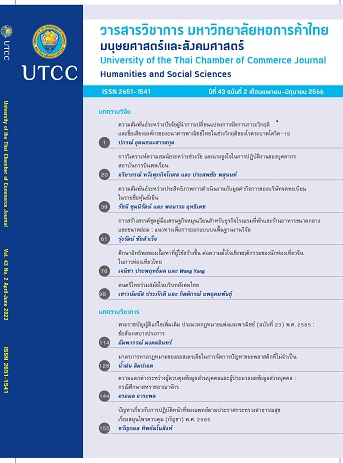The Civil and Commercial Code Amendment Act (No. 23) B.E. 2565 (2022) : some observations
Main Article Content
Abstract
The way of carrying on business frequently changes according to the situation of the world and the country. A partnership or a company is a business entity whose success or failure in most instances depends on the performance to fulfill its objectives. The partnership or the company is a contract whereby two or more people agree to unite for a common undertaking, with the intention of sharing the profits which may be derived therefrom, referring to section 1012 of The Civil and Commercial Code.
Currently, The Civil and Commercial Code Amendment Act (No. 23) B.E. 2565 (2022) was published in the Government Gazette on November 18th, 2022. This Act revised some provisions of the existing Civil and Commercial Code, for example reducing the minimum number of company promoters and shareholders from three to two persons (Article 1097), allowing the company directors to attend Board of Director meetings remotely via video conferencing systems (Article 1162/1), recognizing new way of amalgamation. In the past, only A+B = C was accepted under the law. Now, two or more companies may be amalgamated under one of the following descriptions (1) amalgamation as a new company (A+B = C) (2) amalgamation whereby one company still retains its juristic person status (A+B = A or B) (section 1238).
This article is going to explain the revising issues and providing some observations and suggestions. The author agrees that the amendment of The Civil and Commercial Code is the development of the Thai partnership and company law to become more international standard
Article Details

This work is licensed under a Creative Commons Attribution-NonCommercial-NoDerivatives 4.0 International License.
ลิขสิทธิ์ของบทความ
ผลงานที่ได้รับการตีพิมพ์ถือเป็นลิขสิทธิ์ของมหาวิทยาลัยหอการค้าไทย ห้ามมิให้นำเนื้อหา ทัศนะ หรือข้อคิดเห็นใด ๆ ของผลงานไปทำซ้ำ ดัดแปลง หรือเผยแพร่ ไม่ว่าทั้งหมดหรือบางส่วนโดยไม่ได้รับอนุญาตเป็นลายลักษณ์อักษรจากมหาวิทยาลัยหอการค้าไทยก่อน
References
กิติพงศ์ อุรพีพัฒนพงศ์. (2557). รู้เฟื่อง...การควบรวมกิจการ: โอกาสของธุรกิจไทย (พิมพ์ครั้งที่ 3). กรุงเทพฯ: ตลาดหลักทรัพย์แห่งประเทศไทย.
ตรรกวิทย์ มิ่งขวัญ. (ม.ป.ป.). ญี่ปุ่นหลังโควิด-19: แนวโน้มทางเศรษฐกิจภายในประเทศและไทย. สืบค้นจาก https://www.parliament.go.th/ewtadmin/ewt/parliament_parcy/ewt_dl_link.php?nid=
&filename=article_translate
ประภาศน์ อวยชัย. (2526). คำอธิบายประมวลกฎหมายแพ่งและพาณิชย์ว่าด้วยหุ้นส่วนและบริษัท. กรุงเทพฯ: สำนักอบรมศึกษากฎหมายเนติบัณฑิตยสภา
ประมวลกฎหมายแพ่งและพาณิชย์. (ม.ป.ป.). สืบค้นจาก
https://www.krisdika.go.th/librarian/getfile?sysid=300167&ext=htm
ประเสริฐ เสียงสุทธิวงศ์ (บรรณาธิการ). (2565). รวมคำบรรยายภาคหนึ่ง สมัยที่ 75 ปีการศึกษา 2565: ล. 1. กรุงเทพฯ: สำนักอบรมศึกษากฎหมายแห่งเนติบัณฑิตยสภา.
มหาวิทยาลัยสุโขทัยธรรมาธิราช. (2561). เอกสารโสตทัศน์ชุดวิชา 41324 กฎหมายพาณิชย์ 4: ห้างหุ้นส่วนสามัญ ห้างหุ้นส่วนจำกัด บริษัทจำกัด บริษัทมหาชนจำกัด (พิมพ์ครั้งที่ 33). นนทบุรี: ผู้แต่ง.
ร่างพระราชบัญญัติแก้ไขเพิ่มเติมประมวลกฎหมายแพ่งและพาณิชย์ (ฉบับที่...) พ.ศ. ... . (ม.ป.ป.). สืบค้นเมื่อ 17 ตุลาคม 2565, จาก
https://dl.parliament.go.th/backoffice/viewer2300/web/viewer.php
สำนักงานสภาพัฒนาการเศรษฐกิจและสังคมแห่งชาติ. (ม.ป.ป.). การระดมความคิดเห็นกรอบแผนพัฒนาเศรษฐกิจและสังคมแห่งชาติ ฉบับที่ 13: พลิกโฉมประเทศไทยสู่เศรษฐกิจสร้างคุณค่าสังคมเดินหน้าอย่างยั่งยืน. สืบค้นเมื่อ 17 ตุลาคม 2565, จาก https://www.nesdc.go.th/download/Plan13/Doc/PPTกรอบแผน13สำหรับระดมความเห็น.pdf
สุรศักดิ์ วาจาสิทธิ์, และสหธน รัตนไพจิตร. (2552). ย่อหลักกฎหมายแพ่งและพาณิชย์ หุ้นส่วนและบริษัท (พิมพ์ครั้งที่ 11). กรุงเทพฯ: นิติธรรม.
โสภณ รัตนากร. (2553). คำอธิบายประมวลกฎหมายแพ่งและพาณิชย์ว่าด้วยหุ้นส่วนและบริษัท (พิมพ์ครั้งที่ 12). กรุงเทพฯ: นิติบรรณการ.


